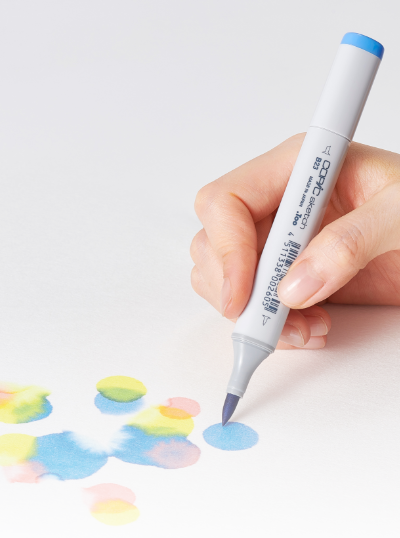Applying Color Schemes
28-02-2022
Analogous, Complimentary, and
Split-Complementary
How can I use these color schemes with my Copic markers?

In the previous blog, we talked about analogous, complimentary, and split complementary color schemes. Now it’s time to put what we’ve learned to the test! In this blog, I’ll be showing how you can apply these color schemes to various drawings with Copic markers. Additionally, each example shown today is available as downloadable line art on our website here. Without further ado, let’s get started!

First up, we have the analogous color scheme. Analogous colors lie next to each other on the color wheel and are one of the most-often-used color palettes both in the artist studio, and in nature! In the example above, I drew a basic feather design and used 3 Copic markers to fill in each feather: B18, BG49, and G09. On the color wheel, blue, blue-green, and green follow each other one by one, so it’s easy to see how these colors would look great together! I chose to use dark colors, but feel free to try other combinations, such as B04, BG05, and G07; or try out a different analogous color scheme altogether, such as RV25, R14, and YR04.

Next, we have the complementary color scheme. Complementary colors lie directly across the color wheel from each other and create a powerful duo. It’s very easy to see examples of this color scheme in fruits and vegetables, especially in the red and green combination of strawberries, tomatoes, red peppers, watermelon, beets, and radishes. For the illustrated strawberries above, I used the Copic colors R27 and G07, and also Y15 for the small seeds, although yellow isn’t part of the complementary color scheme, it adds a nice highlight to the bright red strawberries!

For our last example, we have a split-complementary color scheme, which is created when you combine any given color with the two colors lying on either side of its complement. This can sound confusing, but take violet for example in the pansy illustration above. Pansies are violet, and violet’s complement is yellow. What two colors are on either side of yellow? Yellow-Orange and Yellow-Green. So, that’s why I chose to use V15, V17, and V09 to color the pansies, then Y38 and Y35 to color the inner details, and YG13 and YG11 to color the background. These colors certainly create a vibrant palette for the eyes!

Now that you’ve seen how we can apply these color schemes to drawings with Copic markers, it’s time to put your own skills to the test! You can download the 8.5 x 11 image above from our Line Art Gallery and print it at home on a sheet of marker paper (I recommend Neenah Premium Cardstock) and use the same colors I did or create different color combinations. We can’t wait to see how you #copicwithus !
Sneak peak:
Next month, we’ll be introducing 3 more color schemes…

Read More Articles
Copic Acrea on Canvas
How to use Acrea on various types of Canvas Hello Copic readers! In our previous blog, we wrapped up our discussion on how to use Acrea o...

The Best Papers for COPIC Acrea
How to Layer with Acrea on Various Types of Paper Hello Copic readers! In our previous blog, we wrapped up our discussion on how to use ...

Copic Acrea with Copic Ink
How can Acrea be used with Copic Ink? Greetings Copic readers! In our previous blog, we discussed how Acrea compares with Copic Multil...

Copic Acrea with Multiliners
How does Acrea compare with Copic Multiliner Pens? Greetings Copic readers! In our previous blog, we discussed how Acrea compares to the ...





